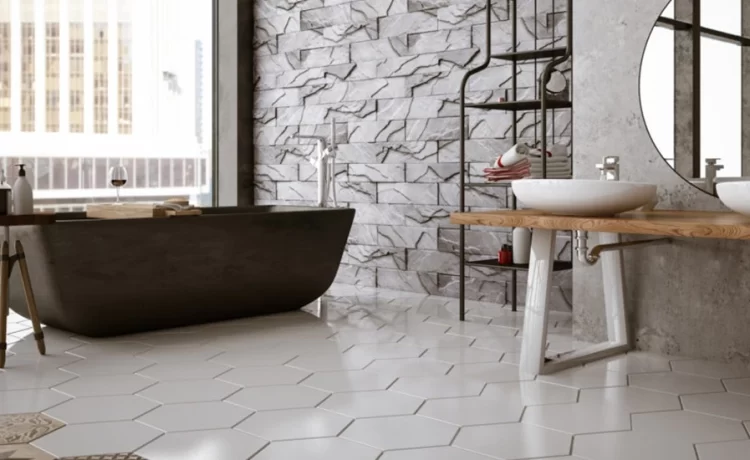Are you thinking of tiling your bathroom or kitchen on your own? With the right tools and careful preparation, tiling is a rewarding DIY project that can elevate your space. This guide will walk you through every stage of the tiling process, from preparation to grouting, ensuring you achieve professional results.
Step 1: Planning and Measuring the Area
Before you start, it’s important to measure the area you’re going to tile accurately. Measure both the width and height of the walls or floors and calculate the total surface area. This will help you determine how many tiles you’ll need to purchase. Always buy 10% more tiles than your calculation to account for breakages or cuts around corners and fixtures.
Step 2: Choosing the Right Tiles
Selecting the appropriate tiles is crucial for the overall look and longevity of your tiling project. For bathroom or wet areas, opt for water-resistant tiles. Porcelain and ceramic are popular choices for DIY enthusiasts because they are durable and relatively easy to work with. For areas like the kitchen backsplash, decorative tiles may be a great option.
Step 3: Preparing the Surface
Before laying any tiles, ensure the surface is clean, flat, and dry. Remove any debris, dust, or old adhesive. If you’re tiling over an existing floor, make sure it’s stable and free from cracks. For wall tiling, it’s best to install a moisture-resistant backing board to avoid potential problems with dampness later on.
Step 4: Gathering Your Tools and Materials
Having the right tools on hand is essential for a smooth tiling process. Here’s a list of must-have tools:
- Tile cutter or wet saw
- Notched trowel
- Tile spacers
- Spirit level
- Rubber mallet
- Grout float
- Tile adhesive
- Grout
- Sealant
With your tools gathered, you’re ready to begin laying the tiles.
Step 5: Laying Out the Tiles
Dry lay the tiles in your workspace to ensure they fit properly and you like the layout before permanently setting them in place. Start from the center of the room or wall and work your way out. Make sure the tiles are evenly spaced and adjust the layout if necessary before applying adhesive.
Step 6: Applying Adhesive and Setting the Tiles
Using a notched trowel, apply tile adhesive to a small section of the surface—about one square meter at a time to prevent the adhesive from drying out. Gently press the tiles into the adhesive, using tile spacers to maintain even gaps between each tile. Tap the tiles lightly with a rubber mallet to ensure they are level.
Step 7: Cutting Tiles for Edges and Corners
For edges and corners, you will need to cut tiles to fit the remaining gaps. A tile cutter or wet saw can help you make clean, straight cuts. For irregular shapes, use a tile nipper to carefully chip away at the tile. Always wear safety goggles when cutting tiles to avoid injury from flying fragments.
Step 8: Grouting the Tiles
Once all the tiles are set and the adhesive has dried (typically 24 hours), it’s time to apply the grout. Using a grout float, press the grout into the gaps between the tiles. Make sure all spaces are filled, then use a damp sponge to wipe away excess grout from the tile surface. Work in small sections and regularly rinse the sponge to avoid leaving a haze on the tiles.
Step 9: Sealing the Grout
Grout is porous and can absorb moisture, so it’s important to apply a sealant to protect it from water damage, particularly in areas like bathrooms. Allow the grout to dry for 48 hours before applying the sealant with a small brush. This step will prolong the life of your tiled surface.
Step 10: Final Touches and Cleaning
After sealing the grout, let it cure for another 24 hours. Once the grout has set, remove any remaining grout haze from the tiles with a soft cloth. Inspect the tiling for any imperfections, and if necessary, touch up any areas with additional grout or adhesive.
Common Mistakes to Avoid When Tiling
Even seasoned DIYers can make mistakes when tiling, but with these tips, you can avoid common pitfalls:
- Not using tile spacers can result in uneven gaps between tiles, affecting the overall look of the project.
- Failing to level tiles properly can lead to an uneven surface.
- Skipping the sealing step can cause grout to absorb moisture and lead to premature wear.
- Applying too much adhesive can make the tiles difficult to align and create an uneven surface.
Benefits of DIY Tiling
Taking on a tiling project yourself can save you a significant amount of money on labor costs. It also gives you full control over the design and layout of your tiles, allowing for a truly personalized finish. While tiling does require some time and patience, the satisfaction of completing the project on your own is well worth the effort.
When to Call a Professional
While tiling can be a rewarding DIY project, some situations call for professional expertise. For example, if you’re working in a large space or dealing with complicated patterns, it might be best to hire a Tiler Melbourne for assistance. Professionals can also help with tricky areas like waterproofing in wet rooms or installing tiles around difficult corners.
Maintaining Your Tiled Surfaces
Once your tiling project is complete, it’s essential to maintain the surfaces properly to ensure they last for years to come. Regular cleaning with a non-abrasive cleaner will keep your tiles looking new. It’s also important to check grout lines periodically and reseal them as needed to prevent moisture buildup and damage. If you notice any loose tiles or cracked grout, address these issues immediately to prevent further problems.
Conclusion
Now that you know how to do tiling yourself, you’re ready to take on your own tiling project. With careful planning, the right tools, and patience, you can achieve professional-looking results in your home. For larger or more complex jobs, or if you require expert assistance, consider hiring a professional for Bathroom Tiling to ensure the highest quality finish. Whether you’re tiling a small bathroom or an entire floor, following these steps will help you create a beautiful, long-lasting tiled surface.







